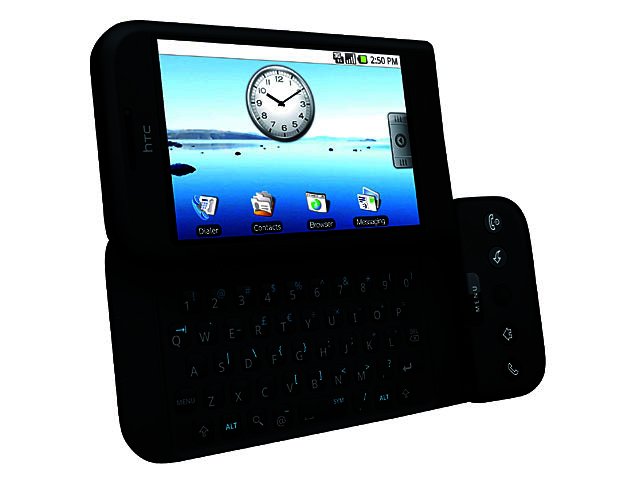Warning: One of the great things about the Android platform is the excellent applications available for the device via Android Market, most of them free. Unfortunately South Africans are unable to download from Android Market. This makes us here at TechSmart feel as if we lost the World Cup to the Aussies, on the last ball of the final over. Sad, angry and severely disappointed. Leaf, the distributor of HTC in SA, provides its own application market service called OMX, but this is little consolation.
The HTC Dream, also known as the G1, is the first Android phone (compare it with the Magic) that was commercially released, more than 6 months ago in the US. Android is of course the open source operating system from Google, and thus integrates really well with all things Google. That means Gmail, Google Maps, Google Calender, Google Talk and YouTube. For example, once signed in to Gmail, a simple process that only requires your username and password, you will receive instant notification on the phone if you receive new mail. Ditto for new Google Talk messages. It was a joy to have things work so smoothly, Google Talk even looks better on the phone than on PC.
The Looks
As far as looks are concerned the HTC Dream is not an iPhone or a Storm, but the design is extremely functional. The Dream is easy to operate from the front panel, with the trackball coming in handy if you don’t want to use the 3.2\" touch-screen, which by the way is very responsive. The QWERTY keyboard reveals itself when the screen is moved up, and is most probably one of the best we’ve seen on a phone. It makes typing and messaging a breeze. Yes it makes the Dream a bit bulky, but if bulky is what it takes to include a real QWERTY keyboard, and not a dreary on-screen one, then we accept the extra pocket bulk with pleasure.
Drag and Drop
The drag and drop interface works better than the one seen on Samsung’s Omnia and Pixon. By flicking left or right with you finger on the screen you access different desktops, so you have the ability to populate the main screen with all your most commonly used icons, the one on the right with all you Google applications, and the other screen with your entertainment features.
Android is Nice
When working on some of HTC’s Windows based smartphones, like the Touch HD, everything looks wonderfully, that is until you hit the dark part of the woods namely the Windows backend. There the fairytale ends and your frustration begins. Android on the other hand seems much less cluttered and better integrated.
We did run into some unexpected trouble though. Firstly, there is no file explorer but that was easily rectified by a download from Leaf’s OMX market place (we liked OI File Manager). There is also no syncing with Windows, as can be done with the HTC Magic (read our review), so although you can set-up your POP3 mail on your phone, you cannot sync it with your Microsoft Outlook. It is also not possible to use the phone as a tethered modem to connect to the Internet from your PC.
Wi-Fi and Browser
We did not have any trouble with the Wi-Fi, once set up it connected to our Wi-Fi and reconnected each time it came in the vicinity. Even with no SIM card inserted it would connect to the Net and receive Gmail.
The excellent Internet browser deserves a mention. Not only is it easy to navigate through a page via the zoom functionalities, but you can also open links in new windows. It is not tabbed browsing yet, but it’s functionally almost the same.
No 3.5mm Jack and no Video
Talking about entertainment for some strange reason the Dream does not include a video player, and we could not find one on Leaf’s OMX offering either. We were also very disappointed that we couldn’t find a 3.5mm jack anywhere on the device, not even on the headset. Although the included headset was not too bad, for us a phone immediately loses its entertainment quality if it does not include a 3.5mm jack to plug in external speakers, headphones or for example in a car’s auxiliary.
Battery (half) life
One of the main problems we had with the Dream is the battery life. It seems that at the end of the day, after very average usage, we always had to recharge. Battery life improved when we switched 3G off and just opted for Edge, but why must one take those kind of steps?
The Final Verdict
We struggle to place the Dream since its business functionality isn’t up there with what’s available from BlackBerry, it’s entertainment assets doesn’t match up with the Nokia XpressMusic 5800, and it hasn’t got the camera we’ve seen on the Samsung’s Pixon.
That’s not to say we didn’t enjoy the Dream. The operating system worked well and integration with Google’s application was top notch. The browser was awesome, and this goes double for the QWERTY keyboard. Unfortunately the Dream is let down by bad battery life, but as a phone that integrates well with Google’s offerings the Dream gets two thumbs up.
PROS
Excellent keyboard, Google integration, nice touch-screen interface.
CONS
No 3.5mm jack, battery life not good, no video, no Outlook sync
USER COMMENTS
Most Read Articles
Read

Magazine Online
TechSmart.co.za is South Africa's leading magazine for tech product reviews, tech news, videos, tech specs and gadgets.
Start reading now >
Download latest issue
Have Your Say
What new tech or developments are you most anticipating this year?
New smartphone announcements (45 votes)
Technological breakthroughs (29 votes)
Launch of new consoles, or notebooks (14 votes)
Innovative Artificial Intelligence solutions (29 votes)
Biotechnology or medical advancements (24 votes)
Better business applications (160 votes)




